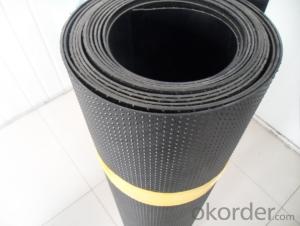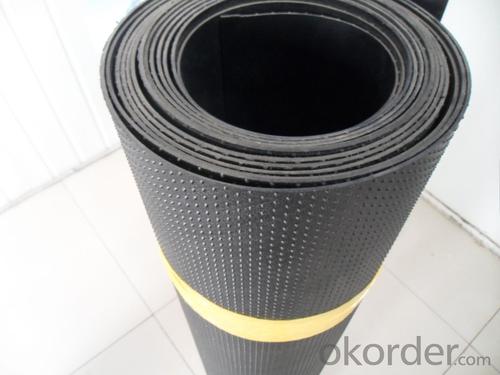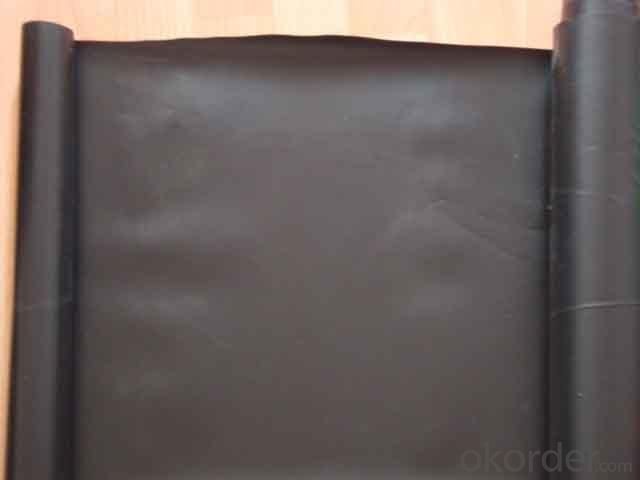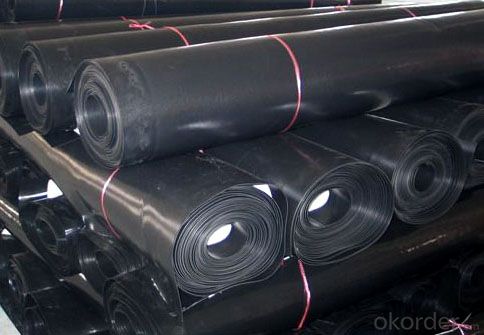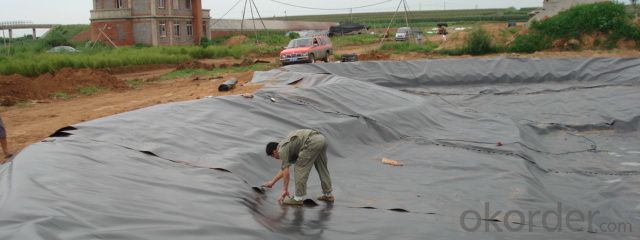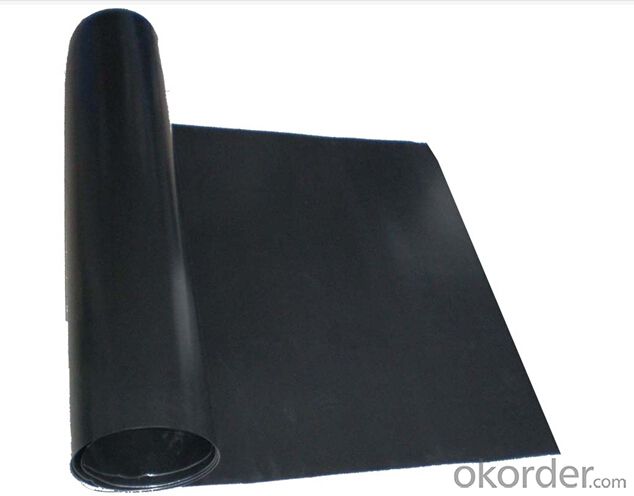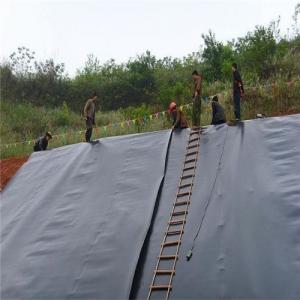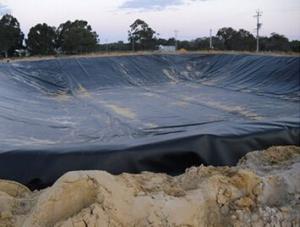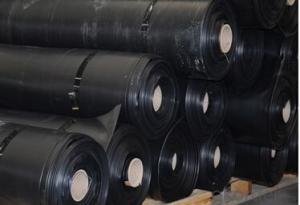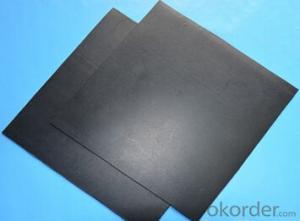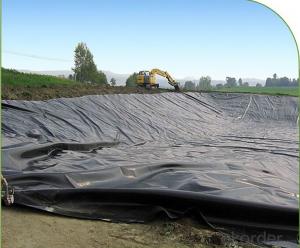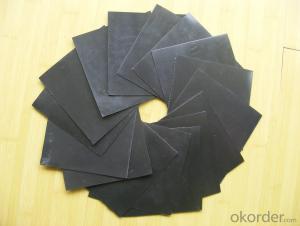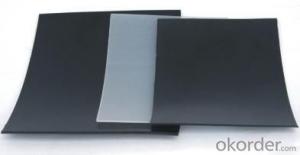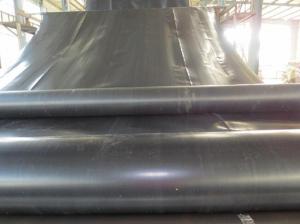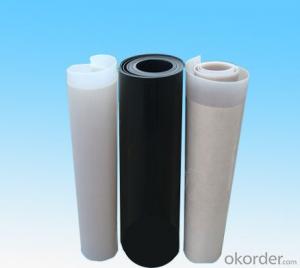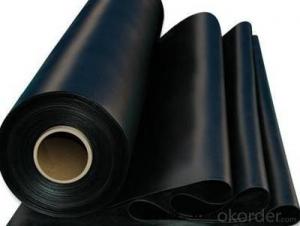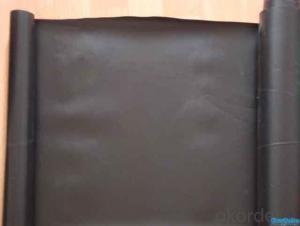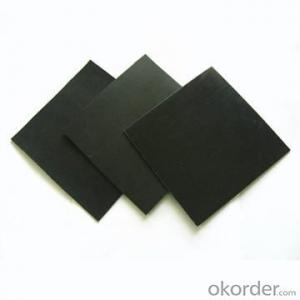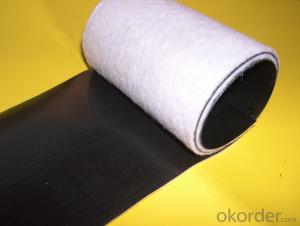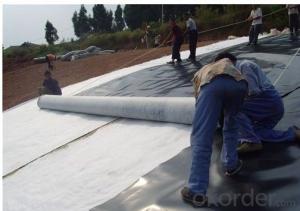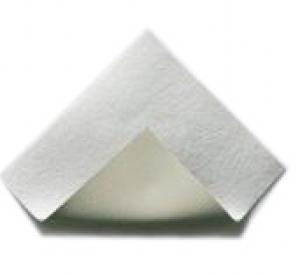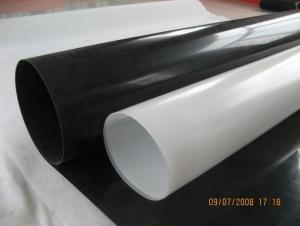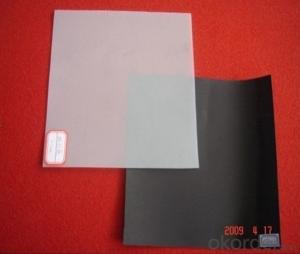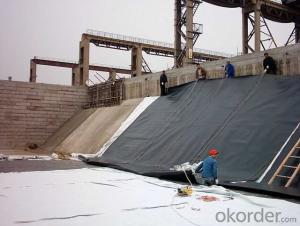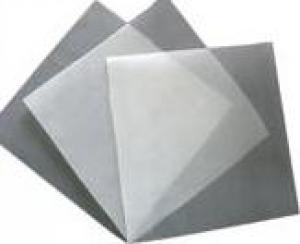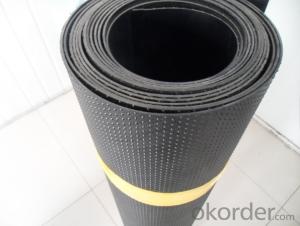Vi-20 LDPE Geomembrane for Pond Liner and Landfill
- Loading Port:
- Qingdao
- Payment Terms:
- TT or L/C
- Min Order Qty:
- 10000 m²
- Supply Capability:
- 300000 m²/month
OKorder Service Pledge
OKorder Financial Service
You Might Also Like
1. Specification and Technical Sheet of LDPE Geomembrane
Iterm | Technical Data | ||||||
Thickness mm | 0.75 | 1 | 1.25 | 1.5 | 2 | 2.5 | 3 |
Density g/cm3 | ≥0.940 | ≥0.940 | ≥0.940 | ≥0.940 | ≥0.940 | ≥0.940 | ≥0.940 |
Yield Strength N/mm | ≥11 | ≥15 | ≥18 | ≥22 | ≥29 | ≥37 | ≥44 |
Break Strength N/mm | ≥20 | ≥27 | ≥33 | ≥40 | ≥53 | ≥67 | ≥80 |
Yield Elongation % | ≥12 | ≥12 | ≥12 | ≥12 | ≥12 | ≥12 | ≥12 |
Break Elongation % | ≥700 | ≥700 | ≥700 | ≥700 | ≥700 | ≥700 | ≥700 |
Tear Resistance N | ≥93 | ≥125 | ≥160 | ≥190 | ≥250 | ≥315 | ≥375 |
Puncture Resistance N | ≥240 | ≥320 | ≥400 | ≥480 | ≥640 | ≥800 | ≥960 |
Carbon Black Content % | 2.0-3.0 | 2.0-3.0 | 2.0-3.0 | 2.0-3.0 | 2.0-3.0 | 2.0-3.0 | 2.0-3.0 |
Standard OIT min | ≥100 | ≥100 | ≥100 | ≥100 | ≥100 | ≥100 | ≥100 |
High Pressure OIT min | ≥400 | ≥400 | ≥400 | ≥400 | ≥400 | ≥400 | ≥400 |
Oven Aging at 85°C % | ≥55 | ≥55 | ≥55 | ≥55 | ≥55 | ≥55 | ≥55 |
UV Resistance % | ≥50 | ≥50 | ≥50 | ≥50 | ≥50 | ≥50 | ≥50 |
2. Introduction of HDPE Geomembrane
LDPE geomembrane is based on the material of plastic film, relative to the HDPE geomembrane has better applied and suppleness, is to update the generation of soil seepage control material. LDPE geomembrane and geotextile glue them into a soil anti-seepage material it has corrosion resistance, good low temperature resistance, light quality, laceration resistant ability and other characteristics; The characteristics of its low cost, high quality and low price is not matched by other same category geotechnical seepage control material.
3. Introduction of HDPE Geomembrane
1), Environmental protection, sanitation, such as landfill, sewage treatment plant, power plant regulation pool, industrial, hospitals, solid wastes, etc.;
2), Water conservancy projects, such as rivers and lakes of reservoir dam seepage and leakage, reinforcement, the canal seepage control, vertical wall, slope protection, etc.;
3), Municipal engineering: the subway, building underground engineering, planting roof, roof garden, sewage pipe seepage control;
4), Polyethylene anti-seepage film applicable garden: artificial lake, river, reservoir and golf course of the bottom of the pond, slope protection, green lawn waterproof, etc;
5), Petrochemical, chemical plants, refineries, storage tanks, seepage control, chemical reaction pool, sedimentation tank lining and secondary lining, etc.
6), Mining: washing pool, pool heap leaching, heap yard, dissolving tank, tank, the bottom line of the yard, tailings anti-seepage, etc;
7), Agriculture: reservoir, the drinking pool, XuShuiTang, waste treatment, seepage of irrigation system;
8), Aquaculture: intensive, factory breeding pool, fish pond, shrimp ponds circle of lining, sea cucumber, slope protection, etc.;
9),Salt industry: saltworks crystallization pool, halogen pool plastic film covering, salt film, salt pond Shan membrane.
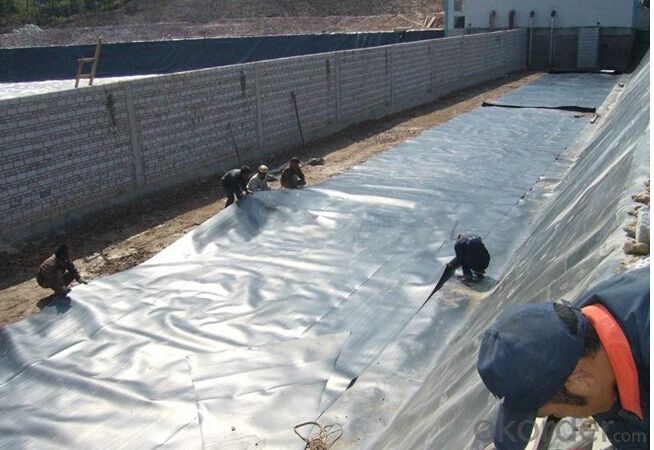
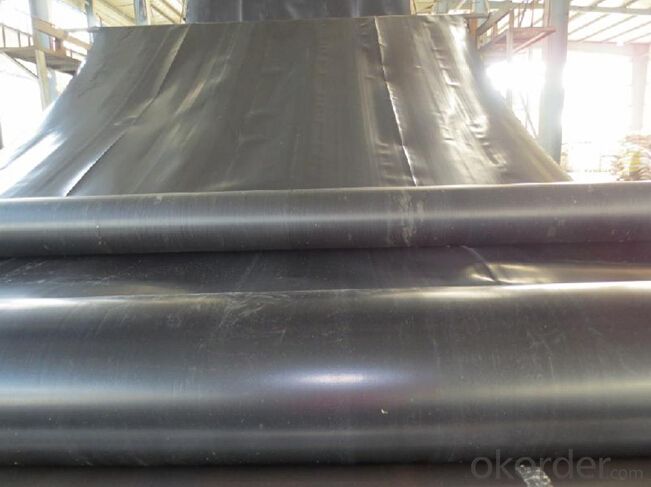
FAQ:
- Q: What can we do for the special customer?
A: Provide custom made service with customer's drawing; We make sure to provide you with the best solutions for your individual case. Whether standard items or non-standard items.
- Q: What can we supply?
A: We provide high levels of communication from start to finish.
- Q: What is our advantage?
A: Top Cemented Carbide has extensive business experience, Fast delivery and high quality.
- Q: How do geomembranes contribute to erosion control in land development and housing construction?
- Geomembranes contribute to erosion control in land development and housing construction by providing a protective barrier against water and soil movement. They are typically used in areas prone to erosion, such as slopes and embankments, to prevent the loss of soil and ensure stability. The impermeable nature of geomembranes helps to control water runoff and reduce the potential for erosion, while also aiding in the containment of pollutants. Additionally, these membranes can be used as liners for ponds and retention basins, further enhancing erosion control measures in construction projects.
- Q: Can geomembranes be used in mining tailings ponds?
- Yes, geomembranes can be used in mining tailings ponds. Geomembranes are impermeable barriers that are commonly used in various environmental containment applications, including mining. They are used to prevent the leakage or seepage of potentially harmful materials from tailings ponds. By lining the ponds with geomembranes, the risk of contamination to surrounding soil and water sources can be minimized, ensuring a more environmentally friendly approach to mining operations.
- Q: how to use landfill geomembrane at site? ?
- calculate the height of good bulldozers,spread out and compacted by rolling road car. cover a layer of membrane.
- Q: What is the difference between eva geomembrane and hdpe geomembrane?
- LDPE. Each has each benefits. What is generally popular on the market is EVA waterproof board. 8mm kind is called geomembrane. The two have different textures. EVA nad LDPE have different textures. 8mm thick kind is called waterproof board. Depend on where it is specifically used. There is only difference of thickness between geomembrane and waterproof board.
- Q: Can geomembranes be used for landfill capping?
- Yes, geomembranes can be used for landfill capping. Geomembranes are impermeable liners made from synthetic materials that can effectively contain and prevent the escape of waste materials in landfills. They are commonly used as a final cover system for landfill capping to provide a barrier against the infiltration of rainwater, leachate, and gas emissions, thus minimizing environmental impacts and protecting groundwater resources.
- Q: What are the requirements for geomembranes used in secondary containment systems?
- The requirements for geomembranes used in secondary containment systems include being chemically resistant, impermeable, and durable. They should also have high tensile strength, puncture resistance, and UV resistance to ensure long-term performance. Additionally, they must meet specific regulatory standards and be installed properly to effectively contain hazardous materials and prevent environmental contamination.
- Q: Architectural glass film benefits include:
- 1, insulation to reduce cooling costs: summer LLumar film can effectively block 79% of the sun's heat, greatly reducing the solar energy into the room, thereby reducing the cost of cooling the building. 2, thermal insulation to reduce heating costs in winter: the low-emissivity (LOW-E) film attached to the inner surface of the ordinary single glazing can reduce heat loss by 30%, reduce indoor heat loss, reduce winter heating costs. 3, blocking 99% of harmful UV rays: ultraviolet in solar radiation is mainly responsible for the damage and color fading of carpet, furniture, art paintings, curtains and many chemical fiber textile and the skin cancer. Energy-saving insulation film can block 99% of UV rays. 4, to reduce the harsh glare and add comfort: direct light at the office table or relaxing at home will lead to tiredness, eye fatigue and distraction. LLumar is a direct installation in the surface of the glazing product, it helps correct light intensity area and back positive zone temperature uneveness and dispersed glare, uncomfortable glare, making employees more comfortable interior, more efficient. 5, the formation of absolute privacy: mount LLumar reflective film may be formed absolute privacy, it can avoid the window watching, protection of private property is not exposed to activities and infringement. 6, improve safety explosion-proof performance: bonding together LLuamr armored dragon film can effectively break the glass, to reduce industrial accidents, earthquakes, typhoons, terrorism, wanton destruction, and property damage caused by theft and other acts against the people.
- Q: What are the features of seepage-proof geomembrane HDPE geomembrane exclusive for solid waste landfill ?
- As for geomembrane performance, the above answers are all to the point. The most important is new material and product performance index is the key.
- Q: How about the warm reflective film?
- The advantage of warm reflective film special for floor heating No.1: it is healthy and environmental friendly. The advantage of floor heating No.2: it is comfortable and fit. The advantage of floor heating No.3: it is of good heat stability. The advantage of floor heating No.4: it is low cost. The advantage of warm reflective film special for floor heating No.5: it wouldn't occupy the usable area. The advantage of floor heating No.6 it wouldn't make noise. The advantage of floor heating No.7: the temperature can be controled. The advantage of floor heating No. 8: it has long service life.
- Q: Can geomembranes be used in oil and gas storage applications?
- Yes, geomembranes can be used in oil and gas storage applications. Geomembranes act as a barrier to prevent leakage of oil and gas, protecting the surrounding environment. They are commonly used in oil and gas storage tanks, ponds, and containment systems to ensure the safe storage and transportation of these substances.
1. Manufacturer Overview
| Location | Taian City,Shandong Province,China |
| Year Established | 2003 |
| Annual Output Value | Above US$100 Million |
| Main Markets | Africa, North America, Eastern Europe, South Asia, Western Europe |
| Company Certifications | ISO9001;IS014001 Certificate |
2. Manufacturer Certificates
| a) Certification Name | |
| Range | |
| Reference | |
| Validity Period |
3. Manufacturer Capability
| a) Trade Capacity | |
| Nearest Port | Qingdao Port;Tianjing Port;Shanghai Port |
| Export Percentage | |
| No.of Employees in Trade Department | 21-30 People |
| Language Spoken: | English; Chinese; |
| b) Factory Information | |
| Factory Size: | 10,000-30,000 square meters |
| No. of Production Lines | Above 10 |
| Contract Manufacturing | Geotechnical Material (Geogrid,Fiberglass/Polyester Geogrid;Geocell;Geonet and Geomat;Plastic Safety Fence);Plastics products;Rubber products;Geotextile;Carpet;Compound geomembrane |
| Product Price Range | Average |
Send your message to us
Vi-20 LDPE Geomembrane for Pond Liner and Landfill
- Loading Port:
- Qingdao
- Payment Terms:
- TT or L/C
- Min Order Qty:
- 10000 m²
- Supply Capability:
- 300000 m²/month
OKorder Service Pledge
OKorder Financial Service
Similar products
Hot products
Hot Searches
Related keywords
